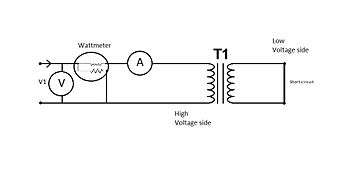Short-circuit test

The purpose of a short-circuit test is to determine the series branch parameters of the equivalent circuit of a real transformer.
Method
The test is conducted on the high-voltage (HV) side of the transformer where the low-voltage (LV) side or the secondary is short circuited. A wattmeter is connected to the primary. An ammeter is connected in series with the primary winding. A voltmeter is optional since the applied voltage is the same as the voltmeter reading. The LV side of the transformer is short circuited. Now with the help of variac applied voltage is slowly increased until the ammeter gives reading equal to the rated current of the HV side. After reaching at rated current of HV side, all three instruments reading (Voltmeter, Ammeter and Watt-meter readings) are recorded. The ammeter reading gives the primary equivalent of full load current IL. As the voltage applied for full load current in short circuit test on transformer is quite small compared to the rated primary voltage of the transformer, the iron losses in transformer can be taken as negligible here.
Procedure
To conduct a short-circuit test on power transformer:
- Isolate the power transformer from service.
- Remove HV/LV jumps and disconnect neutral from earth/ground.
- Short LV phases and connect these short circuited terminals to neutral
- Energise HV side by LV supply.
- Measure current in neutral, HV voltage and HV line currents.
- Wattmeter indicate total cu loss of the transformer
Calculations
is the full-load copper loss
is the applied voltage
is the rated current
is the resistance as viewed from the primary
is the total impedance as viewed from the primary
is the reactance as viewed from the primary
Fault withstand
A short-circuit test for determination of transformer impedance and losses is carried out with relatively low power applied to the transformer, and with winding currents of the same magnitude as in operation. A different form of short-circuit testing is done to assess the mechanical strength of the transformer windings, and their ability to withstand the high forces produced if an energized transformer experiences a short-circuit fault. Currents during such events can be several times the normal rated current. The resultant forces can distort the windings or break internal connections. For large utility-scale power transformers, high-power test laboratories such as the one operated by Powertech Labs near Vancouver, Canada, KEMA at Arnhem, Holland, and CESI Italy have facilities to apply the very high power levels representative of a fault on an interconnected grid system.